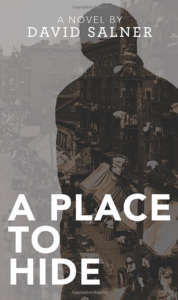
A Place to Hide by David Salner (Loyola College/ Apprentice House), 2021
David Salner’s new novel, A Place to Hide, is a suspenseful, atmospheric, and deeply empathetic work whose themes resonate amid today’s political climate. Salner’s story is ultimately a tribute to community, compassion, and family within a world where tragedy can strike at any time, and love for fellow human beings becomes an essential tool for survival.
James Little, a copper miner from Butte, Montana, is on the run from a sadistic parole officer in the early 1920s. His brother, Frank Little, was a passionate strike organizer who was murdered by vigilantes. This act of violence sent James’ life into turmoil. Gripped with rage and wanting retribution, James was promptly arrested before he had a chance to act and was sentenced to six years behind bars.
We begin with James escaping parole after serving his jail time to travel to New York City, thanks to the kindness of truck drivers along the way. James changes his name to “Bill Waite” and, lacking options for employment, gets a well-paying but grueling job constructing the Holland Tunnel. On the jobsite, he meets a caring, idiosyncratic man named Virgil “Pushy” Shulman (the first Jewish person he’s ever met). Virgil invites Bill to live in his cramped tenement in the Lower East Side with his wife and young daughter. As he and his coworkers endure day after day beneath the Hudson River, Bill slowly but surely starts to build a new path for himself. Once Bill’s face becomes plastered on the front page of a local newspaper for an act of heroism, though, his new lifestyle is put in jeopardy.
From the opening pages onwards, A Place to Hide establishes itself as a brisk, page-turning affair. Readers, just like the protagonist, are thrown into a disorienting position where becoming too comfortable risks danger. As a result, an undercurrent of uneasiness pervades nearly every interaction, no matter how joyous, coming to a boiling point in several nail-biting sequences in which the stakes are high and it’s practically impossible to stop reading.
Salner’s novel isn’t a non-stop thrill ride, however; it’s principally an exploration of Bill’s efforts to forge a new identity. His journey from being a reserved young man living under his brother’s shadow to becoming a new person with a renewed sense of purpose is compelling. He’s a sympathetic character whose grief, regret, and desires render his transformation all the more poignant.
Salner effectively immerses viewers into his tumultuous headspace, reinforcing the anxiety of his fish-out-of-water state early on, and gradually revealing more details about the past he’s running from. When arriving in New York City, for example, Salner writes, “A fierce crowd of businessmen hurried in a whirlwind around him; shoppers — including smart-looking women — peered at him with disdain; two newboys bawled clashing headlines; a hot food vendor gestured with skinny hands, chanting a rigamarole he couldn’t decipher; two ragged men sat a few yards away, backs against a stone wall. The light reflecting off polished shoes flashed over their drooping faces” (25-26). This vivid attention to detail continues throughout, appealing to the senses as Bill is symbolically reborn in this foreign land far from home.
A Place to Hide also does a commendable job at showcasing the rugged humanity of the people Bill encounters. Side-characters such as Virgil and his hard-edged yet loving wife, Rosie, maintain an optimistic attitude in the face of cruel obstacles — finding warmth and relief where they can, despite the exhausting obligations of daily life. Virgil’s friendship with Bill, in fact, illuminates one of the book’s central themes of finding common ground regardless of cultural differences, including within the confines of their back-breaking job.
Indeed, A Place to Hide shines in these scenes of connection between characters, where false preconceptions are eventually discarded as a fuller picture is revealed. Sure, it’s somewhat unbelievable that Bill is able to bond with so many people of varying backgrounds and worldviews, but I admire Salner’s devotion to humanizing almost everyone involved, avoiding blatant stereotypes in favor of depicting them as three-dimensional people (except for the monstrous parole officer in pursuit).
The novel’s sentimentality is quite in-your-face at certain points, particularly during a fast-moving romance midway through, but these moments are often contrasted with those of unexpected violence, both in the past and present. Brutal jolts of reality ensure that nothing can be taken for granted, and they lend instances of levity emotional weight. Heading into a stressful final act, it’s easy to become wrapped up in Bill’s situation and want him to make it out alive.
As a piece of historical fiction, A Place to Hide is an accessible, entertaining, even educational read with nuanced characters and a strong sense of pacing. It’s clear that Salner, himself a former iron ore miner and steelworker, cares deeply about spotlighting these working-class individuals and describing them as full-bodied human beings deserving of respect. Although workplace conditions have improved since the 1920s, A Place to Hide encouraged me to reflect on what is yet to be done. It’s a gritty, immersive slice of literature that, the occasional bout of simplicity notwithstanding, remains absolutely worth delving into.
Alex McPherson is a May 2020 graduate from Truman State University with a double major in English and Communication. He was a Summer 2020 intern at The Missouri Review. He has written film reviews for Cultured Vultures, The Indiependent, Pop Life STL, Entropy Magazine, and The Index.